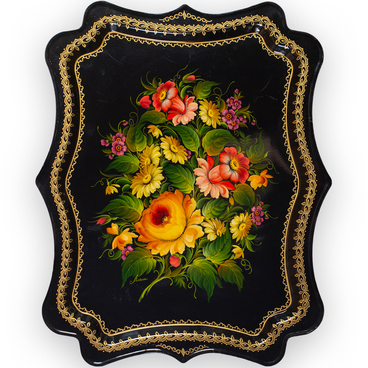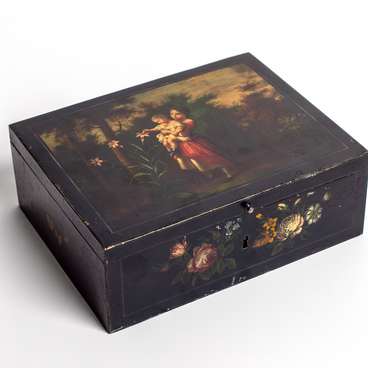This tray was given a figured shape using manual forging. Craftsmen usually had a small workshop set up at their house for two or three workers. There, all the materials, tools, and semi-finished products were kept. The shape of the trays was drawn based on a special pattern using soapstone — a talc-schist that could be used to draw on iron.
For larger trays, ten-pound iron was typically used, which weighed two pounds more than a roofing sheet. Forging was a labor-intensive and demanding process. The trays were forged using special hammers with short handles.
In the next step, the edge was bent and drawn out at the corners and curves. The bottom of the tray was not forged. To add rigidity and strength, the edges of the sheet were toward the bottom with metal wire rolled inside them. On such items of decorative and applied art, the stencil patterns could be applied by both the painters and stencil artists.
First, the pattern was cut on a piece of paper, which was then soaked in hot wax to make the stencil last longer. The pattern was transferred onto the tray surface using special leather swabs. They were dipped in a powder of a golden, silver, or bronze color. The powder was then pressed into the patterned cuts.
At the end of the process, the tray was coated with a lacquer. One technique involved boiling the lacquer in a Russian oven using hemp oil. An image coated with such a lacquer acquired a golden hue and appeared to be pressed into the metal.
The stencil pattern on this tray is distinguished by the fact that it was created without any manual finishing. The artist created a vertical floral composition — a bouquet tied with a ribbon. It consists of two blooming roses and one flower bud. The rose leaves are depicted in a realistic manner.
The roses are also accompanied by numerous smaller flowers. A garland of wildflowers runs along the edge of the base of the tray, repeating all of its curves. A pattern of stylized leaves can be seen on the rim. It serves as a border and frame for the composition. Students practiced by painting the rims of trays. They could be decorated both before and after the main image was created.


